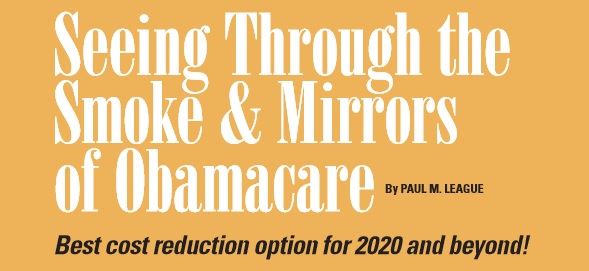By several credible measures, the Affordable Care Act (ACA/Obamacare) has proven a colossal failure, having done little to stem the ever rising costs of healthcare.
Instead, the persistent reality is that of ever increasing Healthcare Exchange costs, medical costs, rising insurance plan premiums, and a steady reduction of plan benefits. Add to this the failed attempt to help offset these costs by shifting them onto consumers.
Fleshing out these ever increasing costs
I use the terminology of “smoke and mirrors” to best describe Obamacare. This legislation is anything but transparent, depending instead on its use of arguably deceptive terminology like “affordable care” when it has proven to be anything but affordable.
The legislation called for the establishment of an expensive bureaucratic infrastructure that birthed federal and state Healthcare Exchanges/Marketplaces, and the Standardized Health Plans offered thereon: Bronze 60, Silver 70, Gold 80, and Platinum 90 Metallic TIER plan designs. These plans require certain costly benefits that many do not need or want (like maternity coverage, preventive care, etc.), resulting in more, not less, overall costs for everyone.
Even projected costs for such things as computer software to run Exchanges, and their calculation of tax subsidies and health plan benefit designs, etc. were grossly underestimated. The result—added costs to the government and consumers, to the tune of multi-billions of dollars.
All of this was done for the supposed reason of bringing about a “competitive marketplace” of benefit-standardized health plans, from multiple insurers. However, in essence this was reinventing the proverbial wheel as the ACA grossly underestimated the exorbitant cost of such an endeavor.
Well…it would have been far more efficient, and cost effective long term, to simply have insurance companies handle all of this, right down to calculating any subsidies, while using the same government Federal Poverty Level (“FPL”) figures as Exchanges now do, and on the same standardized plans.
Returning to our “smoke and mirrors” analogy—the application of such things as tax subsidies have, quite naturally, been interpreted by consumers as some kind of a new government entitlement program, where the connection to costs is completely lost in the smoke, with consumers seeing this as a freebie—which it is not.
Where does the money actually come from to pay for the escalating “infrastructure” costs? Not out of thin air! Rather they come from multiple consumer-foggy sources like administrative fees, penalties and taxes.
Remember, it was the Supreme Court that many years back ruled on the ACA tax legislation; hence its passage was determined to be another, legal way, to impose more, not fewer, taxes on the American public.
How to counter the tax increases and costs of Obamacare?
Since plan benefits were standardized via the passage of the ACA, the only recourse for insurance companies to address their rising claims and systems costs, is to raise health plan premiums. And for the government to reduce benefits by increasing policyholder maximum out-of-pocket liabilities by shifting the costs and risks onto the backs of consumers. This leaves licensed insurance professionals, along with their client consumers, with few practical or effective cost controlling options.
The art of risk shifting by buyers
What’s health insurance really all about? Is it about paying for every nickel and dime healthcare expense? Or, is it really more about capping risk exposure to manageable levels?
Health insurance is best structured, designed and purchased to limit overall financial liability exposure to a level a person can reasonably afford.
Cost effective liability capping options for 2020
Let’s first understand what the limits are to maximum out-of-pocket liabilities going into 2020 using one of the Obamacare standardized health plans, while noting that few persons ever hit yearly maximum liability caps. Typically, incurred medical claims are minor and well within one’s own resources to cover.
The four standardized metallic TIER health plan types are: Bronze 60; Silver 70; Gold 80; and Platinum 90 (not taking into account the “Minimum Coverage” option for certain young persons, or the three enhanced Silver TIER versions for lower income earners).
The Bronze 60 TIER offers the lowest premium, along with the exact same maximum out-of-pocket of TIERS Silver and Gold: $7,800 Individual/$15,600 Family. Only the highest priced plan, Platinum 90, offers a lower maximum out-of-pocket cap of $4,500/$9,000; however, one pays for that lower exposure via substantially higher health plan premiums—not a win-win outcome.
Since all three of these (Bronze/Silver/Gold) have the exact same maximum out-of-pocket, why would anyone ever want to pay the higher premiums for a richer benefits TIER?
Well, if you know you will be facing very high healthcare expenses (claims) in the year to come…then, and only then, might you want to purchase a Platinum 90 Plan with richer benefits and lower maximum out-of-pocket cap.
Further complicating matters here in California (and also in Vermont), is that the legislature has re-imposed the individual tax mandate penalty for not having health insurance in effect from 1/1/2020 onwards:
The mandate, which takes effect on Jan. 1, 2020, requires Californians to have qualifying health insurance coverage throughout the year. Many people already have qualifying health insurance coverage, including employer-sponsored plans, coverage purchased through Covered California or directly from insurers, Medicare, and most Medicaid plans. Under the new mandate, those who fail to maintain qualifying health insurance coverage could face a financial penalty unless they qualify for an exemption.
Generally speaking, a taxpayer who fails to secure coverage will be subject to a penalty of $695 when they file their 2020 state income tax return in 2021. The penalty for a dependent child is half of what it would be for an adult. The penalty is based on your income and the number of people in your household. To avoid a penalty, California residents need to have qualifying health insurance for themselves, their spouse or domestic partner, and their dependents for each month beginning on Jan. 1, 2020.
A look at the numbers
Example: Single, age 40, in zip code 90210 (So. Calif.) using Anthem Blue Cross HMO, with household income as noted below. Annualized savings, plus minimum savings after 6 years of Obamacare, assuming no health plan premium increases, no changes in income, no maximum out-of-pocket increases for 6 years:
W/O Subsidy (at 50k):
Bronze 60 $336.00 X 12 Months = $4,032 X 6 years = $24,192
Platinum 90 $634.00 X 12 Months = $7,608 X 6 years = $45,648
Minimum yearly savings after 6 years: $3,576 X 6 years = $21,456
WITH Subsidy (at 45k):
Bronze 60 $324.00 X 12 Months = $3,888 X 6 years = $23,328
Platinum 90 $623.00 X 12 Months = $7,476 X 6 years = $44,856
Minimum yearly savings after 6 years: $3,588 X 6 years = $21,528
Ask yourself—why spend money on a health insurance plan unless it really benefits you?
If we agree that insurance is best used to limit maximum out-of-pocket liabilities…then why purchase any other TIER than the one that can best help in cost-effectively accomplishing that? No more overpaying, and no more over or under insuring!
Of course, you could opt to have no health insurance at all and simply pay any individual state mandated tax penalty, which is something few would advise. Or, you could do so on the basis that you are so wealthy that you can afford to pay all liabilities from your own resources; however, most understand that it’s simply a cheaper proposition have an insurance company take on liabilities for what amounts, to them, as pennies on the dollar.
Wouldn’t you prefer not to give up those potentially “saved” premium dollars, as noted in our example, versus paying more for a richer first-dollar benefits Silver, Gold, or Platinum TIER Plan?
In some ways of thinking, this is akin to self-funding (specific self-insurance), with an overall maximum out-of-pocket aggregate insurance with an insured-cap on your outside liabilities, and at the lowest premium costs.
Also, if you never reach your maximum out-of-pocket and this goes on for several years (hopefully forever), you will in essence be self-funding your own personal financial “savings” account, on which you can also earn interest, to cover part or all of any later maximum out-of-pocket event. You can also tap into those funds for other expenses, and/or create a pre-tax Health Savings Account (HSA) from which you can reimburse yourself, tax free, on any eligible healthcare expenses for the rest of your life. Or, you can use those HSA accumulated assets to pay for your own private long term nursing/homecare insurance on a tax-favorable basis.
Some will want buy a PPO to use a doctor that is not available via any cheaper HMO plan type, or if not available on a PPO health plan can only access that “indispensable” doctor as a PPO covered out-of-network doctor. Proceed with caution here… PPO insurers will only pay such a non-network doctor at 50% of what they would pay one of their fee-discounted in-network doctors. Not very many doctors or consumers are “happy campers” when those realities hit home, under any circumstances.
The bottom line
Consider transitioning to a Bronze 60 HMO health plan during the next annual open enrollment—a move many are making to efficiently and effectively save thousands annually!
Paul M. League, qualified financial planner (QFP) is the founding principal of League Financial & Insurance Services, a privately held company established in 1984, and located in Palm Desert, Calif. Paul and his company specialize in assisting clients to create, expand & preserve assets. Contact: 800.482.5347, Info@LeagueFinancial.com or www.LeagueFinancial.com.


